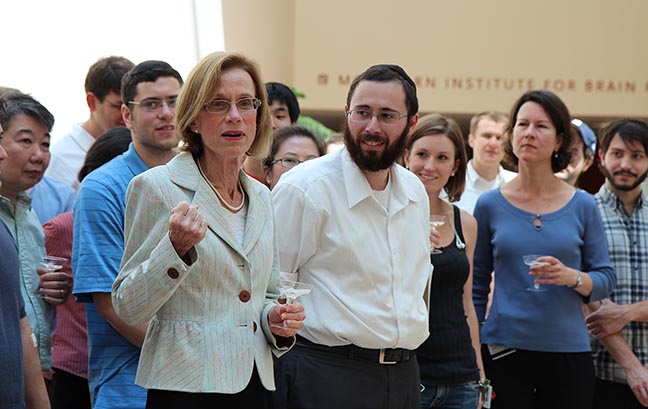Ann Graybiel wins Kavli Prize in Neuroscience
Graybiel will share the $1 million prize with Cornelia Bargmann of the Rockefeller University and Winfried Denk of the Max Planck Institute for Medical Research.

Three MIT researchers including Ann Graybiel are among seven pioneering scientists worldwide named today as this year’s recipients of the Kavli Prizes.
These prizes recognize scientists for their seminal advances in astrophysics, nanoscience and neuroscience, and include a cash award of $1 million in each field. This year’s laureates were selected for their fundamental contributions to our understanding of the outer solar system; the differences in material properties at the nanoscale and at larger scales; and how the brain receives and responds to sensations such as sight, sound and touch.
The Kavli Prizes, awarded biennially since 2008, are a partnership between the Norwegian Academy of Science and Letters, the Kavli Foundation and the Norwegian Ministry of Education and Research. Today’s announcement was made by Nils Christian Stenseth, president of the Norwegian Academy of Science and Letters, and transmitted live at the opening event of the World Science Festival in New York.
King Harald of Norway will present the Kavli Prizes to the laureates at an award ceremony in Oslo on Sept. 4. The ceremony will be hosted by Ã…se Kleveland, former minister of culture for Norway, and Alan Alda, the actor, director, writer and longtime supporter of science.
The Kavli Prize in Astrophysics
The 2012 Kavli Prize in Astrophysics is shared by Jane X. Luu, a technical staff member at MIT’s Lincoln Laboratory, along with David C. Jewitt of the University of California at Los Angeles and Michael E. Brown of the California Institute of Technology. They received the prize “for discovering and characterizing the Kuiper Belt and its largest members, work that led to a major advance in the understanding of the history of our planetary system.â€
In 1992, Luu and Jewitt spotted the first known object in the Kuiper Belt, a region beyond Neptune’s orbit that is more than 30 times Earth’s distance from the sun. Since then, they and others have identified more than 1,000 Kuiper Belt objects. Astronomers are particularly interested in these objects because their composition may resemble the primordial material that coalesced around the sun during the formation of our solar system.
Brown followed in Luu and Jewitt’s footsteps by searching the Kuiper Belt for planet-sized bodies. In 2005, he found Eris, an object about the same size as Pluto but with 27 percent more mass. As a result, astronomers revisited the definition of planets; Pluto was subsequently relegated to “dwarf planet†status.
The Kavli Prize in Nanoscience
The 2012 Kavli Prize in Nanoscience is given to Mildred S. Dresselhaus, Institute Professor Emerita of Physics and Computer Science and Engineering at MIT, “for her pioneering contributions to the study of phonons, electron-phonon interactions, and thermal transport in nanostructures.â€
Over five decades, Dresselhaus has made multiple advances explaining how the nanoscale properties of materials can vary from those of the same materials at larger dimensions. Her early work on carbon fibers and on compounds made up of different chemical species sandwiched between graphite layers — known as graphite intercalation compounds — laid the groundwork for later discoveries concerning buckyballs, carbon nanotubes and graphene.
The Kavli Prize in Neuroscience
The Kavli Prize in Neuroscience is shared by Ann M. Graybiel, Institute Professor in MIT’s Department of Brain and Cognitive Science, along with Cornelia Isabella Bargmann of Rockefeller University and Winfried Denk of the Max Planck Institute for Medical Research. They received the prize “for elucidating basic neuronal mechanisms underlying perception and decision.â€
Graybiel, of MIT’s McGovern Institute for Brain Research, has identified and traced neural loops connecting the outer layer of the brain to a region called the striatum, revealing that these form the basis for linking sensory cues to actions involved in habitual behaviors. Her work has provided a deeper understanding of human ability to make or break habits, and of what goes wrong in disorders involving movement and repetitive behaviors.
Bargmann has used nematode worms to provide insights into the molecular controls of animal behavior, yielding important advances including the discovery of the first evidence that odor response is governed by neurons; of the intracellular signaling pathways between odorant receptors and sensory neurons; and of specific neurons, receptors and neurotransmitters involved in behavior adaption following experience.
Two techniques developed by Denk have answered major questions about how information is transmitted from the eye to the brain: His invention of two-photon laser scanning fluorescence microscopy allowed imaging of living tissue at greater depths and with less unwanted background fluorescence, and his development of serial block-face electron microscopy allowed detailed 3-D imaging of minute structures within tissue.
About the Kavli Prizes
Kavli Prize recipients are chosen biennially by committees of distinguished international scientists recommended by the Chinese Academy of Sciences, the French Academy of Sciences, the Max Planck Society, the National Academy of Sciences and the Royal Society. The recommendations of these prize committees are then confirmed by the Norwegian Academy of Science and Letters.
The Kavli Prizes were initiated by and named after Fred Kavli, founder and chairman of the Kavli Foundation, which is dedicated to advancing science for the benefit of humanity, promoting public understanding of scientific research, and supporting scientists and their work.
For more detailed information on each of the prizes including a video of the 2012 award ceremony, see the Kavli Prize website.




